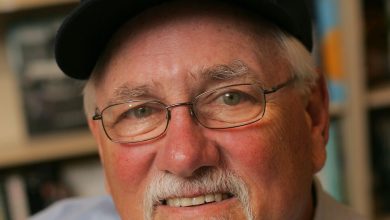Bubba Wallace Is Ebullient, Defiant and Comfortable

Bubba Wallace’s fiancée, Amanda Carter, supplied the positivity. Their Aussiedoodle, Asher, brought the joy. Denny Hamlin and Michael Jordan put Wallace in a fast car, and on Monday he joined Wendell Scott, becoming the second Black driver to win a race at NASCAR’s highest level.
Scott’s victory took nearly 60 years to duplicate, and Wallace made it happen in the YellaWood 500 at Talladega Superspeedway, his home track in Alabama and the place where he came to broader national attention last year.
On June 21, 2020, just weeks after a Minneapolis police officer murdered George Floyd, a member of Wallace’s team reported finding a noose hanging in his garage stall at Talladega. The following day, fellow competitors and members of their pit crews pushed Wallace’s car to the front of pit road before their race.
It was a striking show of solidarity from a sport that was fathered by moonshiners in the hollers of North Carolina and for decades has been hard baked into the American South. The F.B.I., which investigated the incident, eventually concluded that the rope had been hanging in the garage since the year before and that Wallace was not the target of a hate crime.
But Wallace, NASCAR’s only Black driver in the Cup Series, had found his voice and a platform to talk about the racial divide in the United States. He spoke about the racism he experienced on a daily basis competing in an overwhelmingly white sport in front of an audience that may not have wanted to hear what he had to say.
He donned an “I Can’t Breathe” shirt — referring to the last words of Floyd — and stamped the slogan “Black Lives Matter” on his car. Wallace even persuaded NASCAR to ban the display of Confederate flags, which often flew in tandem with Old Glory from recreational vehicles parked in the infield of speedways and visible on television broadcasts.
The efforts did not exactly endear Wallace to a significant portion of the sport’s fans. He has heard the boos. He has read the slurs on social media. Last year, President Donald J. Trump falsely accused Wallace of creating a hoax about the noose.
Even Wallace’s biggest success on a racetrack is stewed in conspiracy theories: His detractors said NASCAR had called the rain-shortened race — after 104 of 188 laps — because Wallace had taken the lead just five laps earlier and the sport needed some feel-good public relations.
After his victory, Wallace was choked with emotion and appeared overwhelmed by his achievement. On Wednesday, however, he was ebullient, defiant and plainly comfortable with the path he has chosen on and off the track.
In fact, Wallace believed going into Talladega that he would reach the checkered flag first and told people close to him so. After all, he had been aiming for just such a moment since he got into auto racing as a young boy.
“You do this to be the best,” Wallace said in a telephone interview on Wednesday. “I can walk out today and say I’m a Cup Series winner. And I’ll take that. My team worked their tails off. I have put the work in. This brings us a lot of confidence, and we are ready to do it again.”
Wallace’s victory hardly came out of nowhere. He is in the midst of the best season of his career, with four top-five finishes.
Denny Hamlin, a fellow driver who co-owns Wallace’s 23XI Racing team with the N.B.A. Hall of Famer Michael Jordan, made what may have been the biggest contribution to Wallace’s success, and the one that cost the least. Hamlin — the winner of 46 races, including three Daytona 500s — told Wallace to stay off social media and spend more time playing his drums or working on his photography.
Hamlin recognized that Wallace was struggling to balance his ambitions as a driver with his place in the public eye. Wallace took his boss’s advice.
“It was a waste of energy,” Wallace said of heeding the critics. “I had to quit worrying about what people thought about me.”
Instead Wallace, who has acknowledged having bouts of depression, said he had sought the help of professionals as well as surrendered to his fiancée’s sunny disposition. Carter told him he was often too self-aware and negative heading into a race.
What Wallace needed was a return to his roots in junior racing when, as a 9- and 10-year-old, he didn’t understand that some of his white competitors and their families were displeased by the presence of an athlete who did not fit the prevailing demographic. Wallace’s mother is Black, and his father is white.
“I was too young to understand it,” he said. “All I knew is that they did not like me winning races. It made me want to come back and win more races.”
Wallace took Asher, adopted a year ago, to the stage for photos after his victory for a good reason. Asher is the kind of distraction he can feel good about.
“He’s been a blessing,” Wallace said. “It’s been a lot of fun watching him grow up.”
Wallace said he would not shrink from the activism that first brought him to the attention of casual sports fans. His “Live to be Different” foundation aims to support individuals in need of educational, medical and social assistance.
Wallace knows he has an expanding platform and believes he has a universal message.
“Be a leader,” he said. “Be good to your brothers and sisters.”
He will turn 28 on Friday, a birthday he plans to spend quietly at home with his family. No media. No sponsor obligations. Just time to think about what success looks like, whether he is driving in circles or changing the way people think.
“It takes people. It takes partners,” Wallace said. “It takes a lot of patience.”




